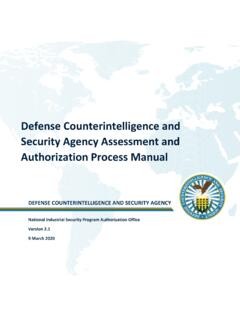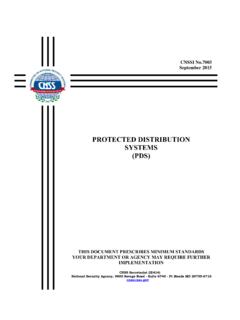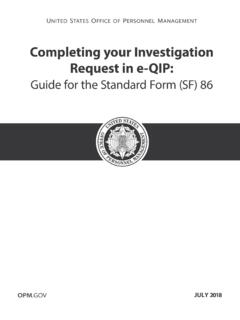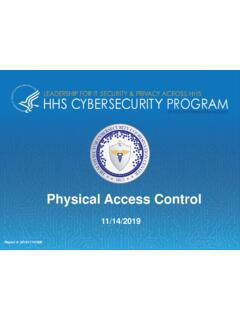Transcription of RISK ASSESSMENT REPORT (RAR) <ORGANIZATION>
1 RISK ASSESSMENT REPORT (RAR) <ORGANIZATION> <SYSTEM NAME> <DATE> Record of Changes: Version Date Sections Modified Description of Changes DD MM YY Initial RAR System Description The <System Name/Unique Identifier> consists of <System Description> processing <Classification Level> data. The risk categorization for this system is assessed as < , Moderate-Low-Low>. < System Name/Unique Identifier> is located <insert physical environment details>. The system <list all system connections and inter-connections, or state has no connections, (wired or wireless)>.
2 This system is used for <system purpose/function>, in support of performance on the <list all program and/or contract information>. The system <provide any system specific details, such as Mobility>. The Information Owner is <insert POC information, including address and phone number>. The ISSM is <insert POC information, including address and phone number>. The ISSO is <insert POC information, including address and phone number>. Scope The scope of this risk ASSESSMENT is focused on the system s use of resources and controls to mitigate vulnerabilities exploitable by threat agents (internal and external) identified during the RMF control selection process, based on the system s categorization.
3 This initial ASSESSMENT will be a Tier 3 or information system level risk ASSESSMENT . While not entirely comprehensive of all threats and vulnerabilities to the system, this ASSESSMENT will include any known risks related to the incomplete or inadequate implementation of the NIST SP 800-53 controls selected for this system. This document will be updated after certification testing to include any vulnerabilities or observations by the independent ASSESSMENT team. Data collected during this ASSESSMENT may be used to support higher level risk assessments at the mission/business or organization level.
4 <Identify assumptions, constraints, timeframe. This section will include the following information: Range or scope of threats considered in the ASSESSMENT Summary of tools/methods used to ensure NIST SP 800-53 compliance Details regarding any instances of non-compliance Relevant operating conditions and physical security conditions Timeframe supported by the ASSESSMENT (Example: security -relevant changes that are anticipated before the authorization, expiration of the existing authorization, etc.).> Purpose <Provide details on why this risk ASSESSMENT is being conducted, including whether it is an initial or other subsequent ASSESSMENT , and state the circumstances that prompted the ASSESSMENT .
5 Example: This initial risk ASSESSMENT was conducted to document areas where the selection and implementation of RMF controls may have left residual risk. This will provide security control assessors and authorizing officials an upfront risk profile.> Risk ASSESSMENT Approach This initial risk ASSESSMENT was conducted using the guidelines outlined in the NIST SP 800-30, Guide for Conducting Risk Assessments. A <SELECT QUALITATIVE / QUANTITATIVE / SEMI-QUANTITATIVE> approach will be utilized for this ASSESSMENT . Risk will be determined based on a threat event, the likelihood of that threat event occurring, known system vulnerabilities, mitigating factors, and consequences/impact to mission.
6 The following table is provided as a list of sample threat sources. Use this table to determine relevant threats to the system. Table 1: Sample Threat Sources (see NIST SP 800-30 for complete list) TYPE OF THREAT SOURCE DESCRIPTION ADVERSARIAL - Individual (outsider, insider, trusted, privileged) - Group (ad-hoc or established) - Organization (competitor, supplier, partner, customer) - Nation state Individuals, groups, organizations, or states that seek to exploit the organization s dependence on cyber resources ( , information in electronic form, information and communications, and the communications and information-handling capabilities provided by those technologies.)
7 ADVERSARIAL - Standard user - Privileged user/Administrator Erroneous actions taken by individuals in the course of executing everyday responsibilities. TYPE OF THREAT SOURCE DESCRIPTION STRUCTURAL - IT Equipment (storage, processing, comm., display, sensor, controller) - Environmental conditions Temperature/humidity controls Power supply - Software Operating system Networking General-purpose application Mission-specific application Failures of equipment, environmental controls, or software due to aging, resource depletion, or other circumstances which exceed expected operating parameters.
8 ENVIRONMENTAL - Natural or man-made (fire, flood, earthquake, etc.) - Unusual natural event ( , sunspots) - Infrastructure failure/outage (electrical, telecomm) Natural disasters and failures of critical infrastructures on which the organization depends, but is outside the control of the organization. Can be characterized in terms of severity and duration. The following tables from the NIST SP 800-30 were used to assign values to likelihood, impact, and risk: Table 2: ASSESSMENT Scale Likelihood of Threat Event Initiation (Adversarial) Qualitative Values Semi-Quantitative Values Description Very High 96-100 10 Adversary is almost certain to initiate the threat event.
9 High 80-95 8 Adversary is highly likely to initiate the threat event. Moderate 21-79 5 Adversary is somewhat likely to initiate the threat event. Low 5-20 2 Adversary is unlikely to initiate the threat event. Very Low 0-4 0 Adversary is highly unlikely to initiate the threat event Table 3: ASSESSMENT Scale Likelihood of Threat Event Occurrence (Non-adversarial) Qualitative Values Semi-Quantitative Values Description Very High 96-100 10 Error, accident, or act of nature is almost certain to occur; or occurs more than 100 times per year. High 80-95 8 Error, accident, or act of nature is highly likely to occur; or occurs between 10-100 times per year.
10 Moderate 21-79 5 Error, accident, or act of nature is somewhat likely to occur; or occurs between 1-10 times per year. Low 5-20 2 Error, accident, or act of nature is unlikely to occur; or occurs less than once a year, but more than once every 10 years. Very Low 0-4 0 Error, accident, or act of nature is highly unlikely to occur; or occurs less than once every 10 years. Table 4: ASSESSMENT Scale Impact of Threat Events Qualitative Values Semi-Quantitative Values Description Very High 96-100 10 The threat event could be expected to have multiple severe or catastrophic adverse effects on organizational operations, organizational assets, individuals, other organizations, or the Nation.













